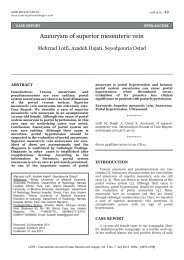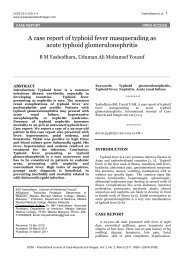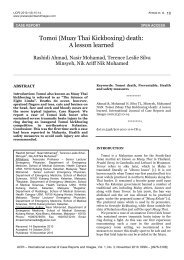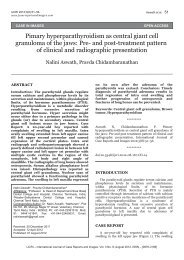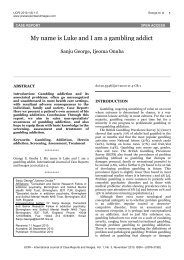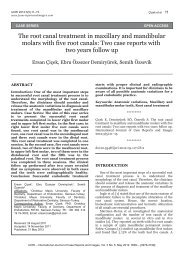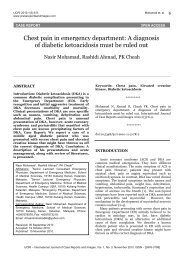Full Text PDF - International Journal of Case Reports and Images ...
Full Text PDF - International Journal of Case Reports and Images ...
Full Text PDF - International Journal of Case Reports and Images ...
You also want an ePaper? Increase the reach of your titles
YUMPU automatically turns print PDFs into web optimized ePapers that Google loves.
IJCRI 201 2;3(11 ):40–42.<br />
www.ijcasereports<strong>and</strong>images.com<br />
Manikam et al. 40<br />
CASE REPORT<br />
OPEN ACCESS<br />
Unique presentation with trimodal transfer <strong>of</strong> a patient<br />
with traumatic bilateral anterior (obturator)<br />
hip dislocation<br />
Rishya Manikam, CS Kumar, Kunalan G, AB Sri Latha, Nasir Mohamad<br />
ABSTRACT<br />
Introduction: Bilateral anterior hip dislocation<br />
presenting late with complete recovery with no<br />
complication is unusually rare. <strong>Case</strong> Report: A<br />
39yearold manual labor presented with<br />
bilateral anterior hip dislocation with nonspecific<br />
neurology following an industrial<br />
accident 20 hours post injury. Closed manual<br />
reduction required femoral block, spinal <strong>and</strong><br />
general anaesthesia with three surgeons<br />
engaging a maneuver not previously described.<br />
Subsequently, skin traction was applied for two<br />
weeks <strong>and</strong> was discharged with nonweight<br />
bearing advice for another four weeks. Patient<br />
on his regular clinic follow up was subjected to<br />
various modalities <strong>of</strong> physiotherapy in view <strong>of</strong><br />
his job nature requiring early return to work.<br />
Regular followup <strong>of</strong> three years did not reveal<br />
any evidence <strong>of</strong> avascular necrosis <strong>of</strong> the<br />
femoral heads <strong>and</strong> he obtained full function <strong>of</strong><br />
both his hip joints. Conclusion: The mode <strong>of</strong><br />
trasport which results in the delay in seeking<br />
treatment.<br />
Rishya Manikam 1 , CS Kumar 2 , Kunalan G 2 , A.B. Sri<br />
Latha 1 , Nasir Mohamad 3<br />
Affiliations: 1<br />
Trauma And Emergency Department,<br />
University Malaya Medical Centre, Kuala Lumpur,<br />
2<br />
Orthopedics Department, University Malaya Medical<br />
Centre, Kuala Lumpur; 3<br />
Accident And Emergency<br />
Department, University Science Malaysia Medical Centre,<br />
Kota Bahru.<br />
Corresponding Author: Dr. Rishya Manikam, Head,<br />
Trauma And Emergency Department, University Malaya,<br />
Lembah Pantai, 50603, Kuala Lumpur, Malaysia; Ph:<br />
+603794941 98; Fax: +603794941 98; Emailrishyaman@yahoo.com<br />
Received: 31 Ocboter 2011<br />
Accepted: 23 January 201 2<br />
Published: 01 November 201 2<br />
Keywords: Traumatic, Anterior, Bilateral, Hip<br />
Dislocations<br />
*********<br />
Manikam R, Kumar CS, Kunalan G, Latha ABS,<br />
Mohamad N. Unique presentation with trimodal<br />
yransfer <strong>of</strong> a patient with traumatic bilateral anterior<br />
(Obturator) hip dislocation. <strong>International</strong> <strong>Journal</strong> <strong>of</strong><br />
<strong>Case</strong> <strong>Reports</strong> <strong>and</strong> <strong>Images</strong> 2012;3(11):40–42.<br />
*********<br />
doi:10.5348/ijcri201211219CR12<br />
INTRODUCTION<br />
Bilateral traumatic anterior hip dislocations caused<br />
by industrial accident is rare. Its rarity is evident with<br />
only eleven cases reported in English literature [1]. Here<br />
we report a case <strong>of</strong> traumatic bilateral anterior hip<br />
dislocation; its presentation delay, mechanism <strong>of</strong> injury,<br />
mode <strong>of</strong> patient transfer to hospital <strong>and</strong> the modified<br />
reduction technique. We also reviewed literature on the<br />
various modality <strong>of</strong> treatment advocated for this<br />
unusual presentation.<br />
CASE REPORT<br />
A 39yearold manual labor at a construction site<br />
from a rural area with poor transportation<br />
infrastructure, first presented to our emergency room<br />
20 hours post injury to both his hips. He was in a<br />
squatted position at the time <strong>of</strong> injury. A brick<br />
impacting machine lost control <strong>and</strong> compressed him<br />
from the front <strong>and</strong> back, fulcruming his perineum<br />
against the hard ground. He fell forward with both his<br />
hips in full flexion, wide abduction <strong>and</strong> external<br />
rotation. He was in prone position for about 20 minutes<br />
IJCRI – <strong>International</strong> <strong>Journal</strong> <strong>of</strong> <strong>Case</strong> <strong>Reports</strong> <strong>and</strong> <strong>Images</strong>, Vol. 3 No. 11 , November 201 2. ISSN – [0976-31 98]
IJCRI 201 2;3(11 ):40–42.<br />
www.ijcasereports<strong>and</strong>images.com<br />
Manikam et al. 41<br />
before getting help to lie in supine position. He was not<br />
able to move his hips <strong>and</strong> being in an awkward position,<br />
he was carried by his colleagues where one <strong>of</strong> them<br />
supported the torso by holding under his armpits <strong>and</strong><br />
two others held his back <strong>and</strong> pelvis with their bare<br />
h<strong>and</strong>s. The fourth colleague supported both the lower<br />
limbs to prevent them from too much movement. He<br />
was shifted onto the back <strong>of</strong> a 4wheel drive which took<br />
them to a riverside where a boat was waiting for them.<br />
As there were no available splints, his colleagues used<br />
tree branches to anchor him to the boat. He was in the<br />
same position for another 45 minutes <strong>of</strong> the boat ride<br />
which took him to a helicopter l<strong>and</strong>ing site. Upon<br />
arrival to the site, he was again carried by his colleagues<br />
in the same manner to a helicopter waiting to transport<br />
him to a general hospital. With the help <strong>of</strong> a trained<br />
paramedic, the patient was then secured in the<br />
passenger bay <strong>of</strong> the helicopter using several safety<br />
harnesses. The paramedic also administered<br />
intravenous Pethidine to calm the patient during the air<br />
transfer. In short, a trimodal mode <strong>of</strong> transport was<br />
used in transferring the patient to definitive care.<br />
Though he was spared <strong>of</strong> other major organ injuries,<br />
his complaints were severe pain, deformity <strong>and</strong> inability<br />
to move both his hips. Examination revealed both his<br />
hips were in wide abduction, flexion <strong>and</strong> external<br />
rotation. Passive movement <strong>of</strong> his hips was nearly<br />
impossible. There was patchy neurology in both the<br />
lower limbs. The myotome or dermatome could not be<br />
specified to either solely L1, L2, etc. as the patient had a<br />
mixture <strong>of</strong> all the dermatomes in a patchy manner.<br />
Nevertheless, post reduction, there was no neurology.<br />
No foot drop was noted as the patient had a<br />
multimodal transfer in which an anticipation <strong>of</strong> foot<br />
drop was expected. We assumed that since nontrained<br />
individuals helped with the transfer, there could be a<br />
possibility <strong>of</strong> his leg undergoing traction at some point<br />
<strong>of</strong> the transfer. Fortunately, the femoral nerve was not<br />
affected in patient. There were superficial facial injuries<br />
<strong>and</strong> he was hemodynamically stable. Appropriate<br />
analgesics were administered to counter his severe pain<br />
prior to the radiographs. Radiographic studies revealed<br />
bilateral anterior hip dislocations into the obturator<br />
foramen (Figure 1).<br />
Close reduction using 75 mg Pethidine <strong>and</strong> 7.5 mg<br />
Midazolam as sedation was unsuccessful. In the<br />
operating room, initially, bilateral femoral block was<br />
attempted with great difficulty by the anaesthetist in<br />
view <strong>of</strong> the awkward positioning <strong>of</strong> the patient. Though<br />
successful, it was inadequate to counter the muscle<br />
spasm but it was sufficient to position the patient for<br />
spinal anesthesia. In spite <strong>of</strong> successful spinal<br />
anesthesia, it was difficult for both surgeons <strong>and</strong><br />
patient to cooperate with the external close maneuvers.<br />
Though the anaesthetist prefered the regional block but<br />
due to poor responce <strong>of</strong> the patient, general anaesthesia<br />
was finally given. The general anaesthetic was<br />
conducive for the surgeons to perform the maneuvers as<br />
the patient was fully relaxed. Unlike individual hip<br />
posterior dislocation, where countertraction to the<br />
anterior iliac crest <strong>and</strong> hip flexion to 90 degrees, slight<br />
Figure 1: Bilateral Anterior Hip Dislocation into Obturator<br />
Foramen<br />
abduction while pulling in line with the femur would<br />
suffice to reduce the dislocation, this type <strong>of</strong> dislocation<br />
did not respond to the usual method.<br />
In this patient, we first placed a s<strong>and</strong>bag over the<br />
sacrum in line with the spine to obtain sag <strong>of</strong> both the<br />
gluteal muscles. Then, we engaged one surgeon for<br />
pelvic stabilization by tractioncountertraction over the<br />
anterior iliac crest <strong>and</strong> perineum. Two other surgeons<br />
simultaneously applied axial traction to each leg with<br />
internal rotation <strong>and</strong> application <strong>of</strong> pressure to the<br />
medial side <strong>of</strong> the proximal thigh bringing the femoral<br />
head towards the acetabulum <strong>and</strong> adduction. Both the<br />
hips reduced simultaneously. Post reduction telescoping<br />
proved its stability upon reduction. Post reduction<br />
radiographs showed the hips were correctly positioned<br />
<strong>and</strong> did not reveal any fractures. No CT or MRI was done<br />
post reduction as the centre was not equipped with one<br />
at that time. We were dependent on the radiographs <strong>and</strong><br />
the clinical outcome. There were no foot drops.<br />
Subsequently, skin traction was applied for two<br />
weeks in the ward. Wheel chair mobilization was<br />
commenced with regular ultrasound heat therapy <strong>and</strong><br />
static quadriceps <strong>and</strong> calf exercises. He was discharged<br />
from the ward with nonweight bearing advice for<br />
another four weeks. On followup at one month, we were<br />
rather surprised to see him fully weight bear without any<br />
pain <strong>and</strong> having full range <strong>of</strong> movement over his hip<br />
joints. The patchy neurology fully recovered. He was<br />
back to full manual labor the following week. Six<br />
monthly followup for three years with radiographs did<br />
not reveal any evidence <strong>of</strong> avascular necrosis <strong>of</strong> both<br />
femoral heads <strong>and</strong> patient was pain free.<br />
DISCUSSION<br />
Hip dislocations are becoming more common due to<br />
increased high velocity road traffic accidents. Posterior<br />
hip dislocations are more common. Anterior hip<br />
IJCRI – <strong>International</strong> <strong>Journal</strong> <strong>of</strong> <strong>Case</strong> <strong>Reports</strong> <strong>and</strong> <strong>Images</strong>, Vol. 3 No. 11 , November 201 2. ISSN – [0976-31 98]
IJCRI 201 2;3(11 ):40–42.<br />
www.ijcasereports<strong>and</strong>images.com<br />
Manikam et al. 42<br />
dislocations are being reported to occur in only 10–11%<br />
<strong>of</strong> the total hip dislocations. Bilateral, simultaneous<br />
anterior hip dislocations are even rarer <strong>and</strong> a number <strong>of</strong><br />
cases have been reported by different authors. The most<br />
common cause in most <strong>of</strong> the cases reported has been<br />
road traffic accident. In our case, it was an industrial<br />
accident <strong>and</strong> the mechanism <strong>of</strong> injury that made this<br />
case unique. Nevertheless, all the authors highlighted on<br />
the position <strong>of</strong> the hips at the time <strong>of</strong> impact being in<br />
extreme abduction <strong>and</strong> flexion [1, 2].<br />
Patients with bilateral anterior dislocation usually<br />
present with flexed, externally rotated leg <strong>and</strong> abducted<br />
hips. Radiographs are usually diagnostic but in case <strong>of</strong><br />
doubt, CT scan will definitely reveal the type <strong>of</strong><br />
dislocation. Anterior hip dislocation can be classified as<br />
obturator, perineum <strong>and</strong> pubic. The direction <strong>of</strong> the hip<br />
dislocation depends on the position <strong>of</strong> the hip at the<br />
time <strong>of</strong> impact [3, 4].<br />
Most authors used the Allis’s maneuvers to achieve<br />
reduction i.e., patient in supine position, knee flexed,<br />
pelvis stabilized, lateral traction force to inside <strong>of</strong> thigh,<br />
longitudinal traction is applied in line with axis <strong>of</strong><br />
femur, <strong>and</strong> hip in slightly flexed position. The essential<br />
feature is traction in line <strong>of</strong> deformity, followed by<br />
gentle flexion <strong>of</strong> hip to 90 degrees. The hip is gently<br />
rotated internally <strong>and</strong> externally with continued<br />
longitudinal traction until reduction is achieved. These<br />
maneuvers are ideally done under general anaesthesia.<br />
In our case, three modalities <strong>of</strong> anesthesia were used to<br />
get the ideal relaxation <strong>of</strong> the muscles in spasm. This<br />
technique was used after fully underst<strong>and</strong>ing the various<br />
forces acting onto the hip joints at the time <strong>of</strong> injury.<br />
Patient’s compliance to post reduction therapy <strong>and</strong><br />
urgency to return to active work also contributed to<br />
defying the golden rule for Avascular Necrosis (AVN)<br />
[5–7].<br />
The bilateral anterior hip dislocations in this case<br />
were a rare <strong>and</strong> significant injury. The outcome <strong>of</strong> the<br />
treatment was encouraging. Although we realize that the<br />
usefulness <strong>of</strong> data based on a single case is limited, we<br />
are encouraged by the outcome in this case <strong>and</strong> believe<br />
that the technique used is a viable option in bilateral<br />
anterior hip dislocation.<br />
CONCLUSION<br />
The time taken in seeking immediate treatment for<br />
bilateral antrerior hip dislocation is essential for good<br />
outcome. Although there was a significant delay in<br />
seeking treatment in this patient due to the logistic<br />
mode <strong>of</strong> transfer,the patient was lucky to have a<br />
complete recovery. It is essential to improve the<br />
prehospital care aspect especially in the rural areas.<br />
*********<br />
Author Contributions<br />
Rishya Manikam – Conception <strong>of</strong> design, Acquisation <strong>of</strong><br />
data, Analysis <strong>and</strong> interpretation <strong>of</strong> data, Drafting the<br />
article, Critical revision <strong>of</strong> the article, Final approval <strong>of</strong><br />
the version to be published<br />
CS Kumar – Conception <strong>of</strong> design, Acquisation <strong>of</strong> data,<br />
Analysis <strong>and</strong> interpretation <strong>of</strong> data, Drafting the article,<br />
Critical revision <strong>of</strong> the article, Final approval <strong>of</strong> the<br />
version to be published<br />
Kunalan G – Conception <strong>of</strong> design, Acquisation <strong>of</strong> data,<br />
Analysis <strong>and</strong> interpretation <strong>of</strong> data, Drafting the article,<br />
Critical revision <strong>of</strong> the article, Final approval <strong>of</strong> the<br />
version to be published<br />
A B Sri Latha – Conception <strong>of</strong> design, Acquisation <strong>of</strong><br />
data, Analysis <strong>and</strong> interpretation <strong>of</strong> data, Drafting the<br />
article, Critical revision <strong>of</strong> the article, Final approval <strong>of</strong><br />
the version to be published<br />
Nasir Mohamad – Conception <strong>of</strong> design, Acquisation <strong>of</strong><br />
data, Analysis <strong>and</strong> interpretation <strong>of</strong> data, Drafting the<br />
article, Critical revision <strong>of</strong> the article, Final approval <strong>of</strong><br />
the version to be published<br />
Guarantor<br />
The corresponding author is the guarantor <strong>of</strong><br />
submission.<br />
Conflict <strong>of</strong> Interest<br />
Authors declare no conflict <strong>of</strong> interest.<br />
Copyright<br />
© Rishya Manikam et al. 2012; This article is<br />
distributed under the terms <strong>of</strong> Creative Commons<br />
Attribution 3.0 License which permits unrestricted use,<br />
distribution <strong>and</strong> reproduction in any means provided<br />
the original authors <strong>and</strong> original publisher are properly<br />
credited. (Please see www.ijcasereports<strong>and</strong>images.com<br />
/copyrightpolicy.php for more information.)<br />
REFERENCES<br />
1. Anna Domingo, Josep M. Segur, Lazaro Saz,<br />
Sebastian GarciaRamiro. Unusual traumatic<br />
anterior bilateral hip dislocation. J Orthop Surg<br />
Traumatol 2008;18:475–8.<br />
2. R. Tezcan, R. Erginer, M. Babacan. Bilateral<br />
Traumatic Anterior Dislocation Of The Hip: Brief<br />
Report. J Bone Joint Surg(Br) 1988;70B:148–9<br />
3. T S Sethi, M K Mam, R K Kakroo. Bilateral<br />
Traumatic anterior dislocation <strong>of</strong> the hip. The<br />
<strong>Journal</strong> <strong>of</strong> Trauma 06/1987;27(5):573–4.<br />
4. N Terahata, H Matsui, N Makiyama. Bilateral<br />
anterior dislocations <strong>of</strong> the hips. <strong>International</strong><br />
Orthopaedics 02/1996;20(2):125–6.<br />
5. A L Akinyoola, A A Abiodun. Bilateral traumatic<br />
anterior hip dislocation–a case report. West African<br />
journal <strong>of</strong> medicine. 24(3)272–3.<br />
6. Zamani MH et al. Bilateral traumatic anterior<br />
dislocation <strong>of</strong> hip: case report. Clin Orthop<br />
1981;161:203–6.<br />
7. Gibbs A. Bilateral obturator dislocation <strong>of</strong> the hip<br />
joint. Injury 1981;12:250–1.<br />
IJCRI – <strong>International</strong> <strong>Journal</strong> <strong>of</strong> <strong>Case</strong> <strong>Reports</strong> <strong>and</strong> <strong>Images</strong>, Vol. 3 No. 11 , November 201 2. ISSN – [0976-31 98]



